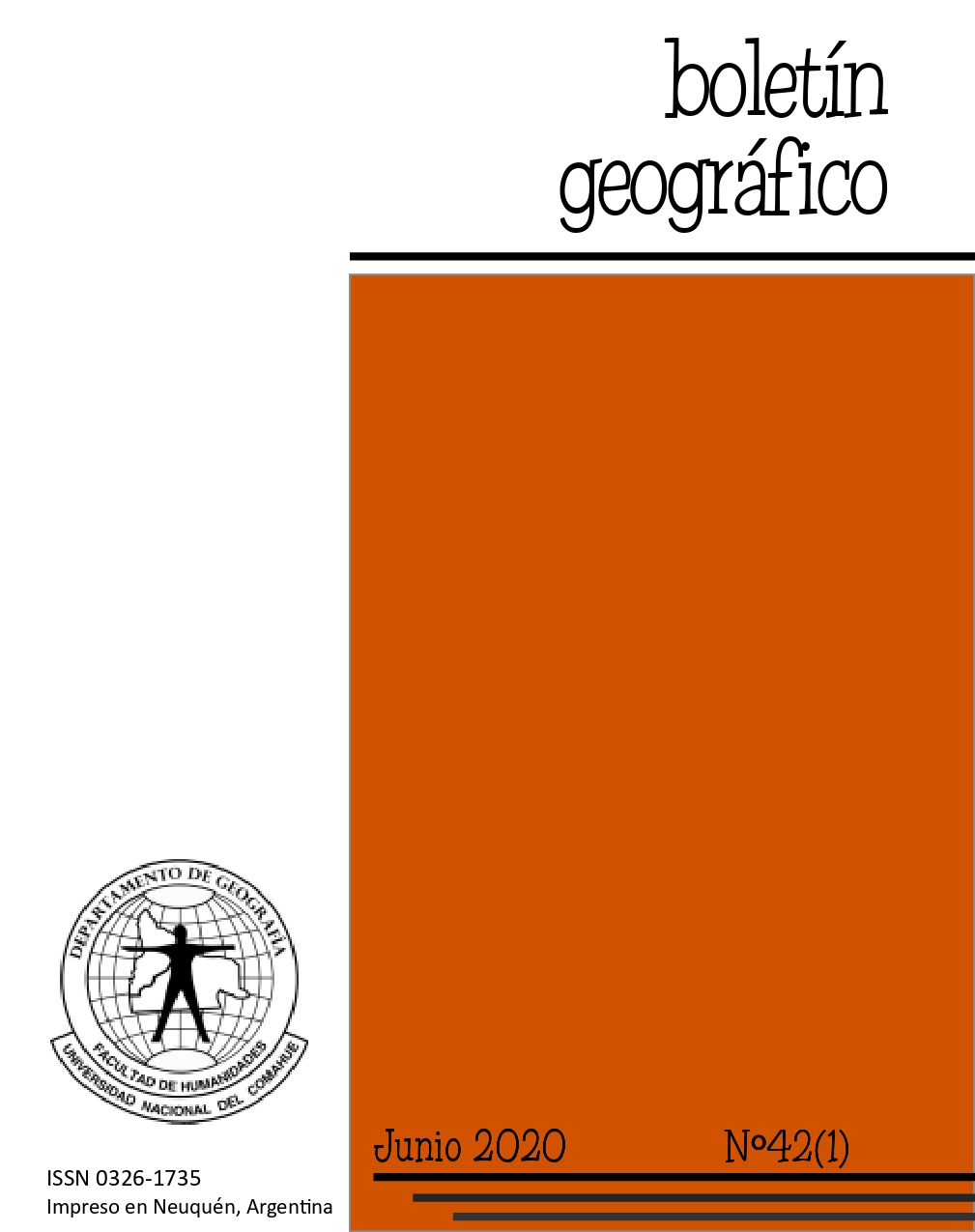TENDENCIA Y VARIABILIDAD CLIMATICA; SUBREGIONES PAMPEANAS, ARGENTINA (1960-2010)
Keywords:
subregiones climáticas, variabilidad, tendenciaAbstract
Los incrementos en las precipitaciones y temperaturas del aire registrados en los últimos años influyen en distintos sistemas socioeconómicos en múltiples escalas. La Región Pampeana Argentina se caracteriza por una gran extensión y diversidad de actividades agrícolas, ganaderas y turísticas, las cuales dependen o se ven afectadas por las variaciones del clima. Sin embargo, dicha variabilidad no es similar en toda la región. El presente trabajo tiene como objetivo analizar la variabilidad climática a escala subregional e identificar períodos y eventos climáticos extremos en cada subregión. El periodo de estudio es 1960-2010 y se tuvieron en cuenta la Precipitación, Temperatura del aire, Humedad relativa y Velocidad del viento. Se observó que cada subregión posee una variabilidad particular, dependiendo de la variable o fenómeno considerado. Tanto la precipitación como la temperatura del aire muestran tendencias positivas, sin embargo esto no ocurre en todas las subregiones. La variación de la humedad relativa responde en general a las máximas precipitaciones y a la cercanía al mar. La velocidad media del viento en la región también es heterogénea, estando incluso, las subregiones de mayor y menor velocidades medias lindantes. La variabilidad climática específica de cada subregión permite conocer la combinación de limitaciones y potencialidades para el uso de tierras en cada una, ya que la mayor parte de territorio es el soporte de importantes sistemas ecológicos y productivos.
Downloads
References
Aliaga, V.S., Ferrelli, F., Alberdi-Algarañaz, E.D., Bohn, V.Y. & Piccolo, M.C. (2016). Distribución y variabilidad de la precipitación en la Región Pampeana, Argentina. Cuadernos de Investigación Geográfica, 42(1), 261-280.
Aliaga, V.S., Ferrelli, F. & Piccolo, M.C. (2017). Regionalization of climate over the Argentine Pampas. International Journal of Climatology. 37(S1), 1237-1247.
Bridgman, H.A. & Oliver, J.E. (2006). The global climate system: patterns, processes, and teleconnections. Cambridge UniversityPress.
Camilloni, I.A. (2018) Argentina y el cambio climático; Asociación Argentina para el Progreso de las Ciencias; Ciencia e Investigación; 68; 5; 11-2018; 5-10.
Davey, M.K., Brookshaw, A. & Ineson, S. (2014). The probability of the impact of ENSO on precipitation and near-surface temperature. Climate Risk Management, 1, 5-24.
Doyle, M., Saurral, R. & Barros, V.R. (2012). Trends in the distributions of aggregated monthly precipitation over the Plata Basin. Int. Journal of Climatology, 32, 2149-2162.
Forte Lay, J., Scarpati, O. & Capriolo, A. (2008). Precipitation variability and soil water content in Pampean Flatlands (Argentina). Geofísica Internacional, 47 (4), 341-354.
Gasca Zamora, J. (2009). Geografía regional. La región, la regionalización y el desarrollo regional. Instituto de Geografía – UNAM. México.
Giovannettone, J., Paredes, F., Seiler, R.& Ravelo, A. (2013). Effectiveness of a new method (software) to evaluate the impacts of the Madden-Julian oscillation on rainfall in Central and South America. Aqua-Lac, 5(2), 44-55
Godoy, A.A., Aldeco, L.S.& Ferreira, L.J. (2018). Análisis de los forzantes de la escala intraestacional a estacional durante la sequía 2017-2018. XIII CONGREMET, SMN. Departamento de Agrometeorología. Rosario, Santa Fe, Argentina.
Grimm, A.M. (2011). Interannual climate variability in South America: impacts on seasonal precipitation, extreme events, and possible effects of climate change. Stochastic Environmental Research and Risk Assessment, 25(4), 537-554.
Hulme, M. & Sheard, N. (1999). Climate change scenarios for Argentina. Climatic Research Unit, Norwich, UK.
Labraga, J.C, Brandizi, L.D. & López, M.A. (2011). Avances en el pronóstico climático de las anomalías de lluvia en la Región Pampeana. Meteorológica, 36(2), 59-71.
Magrin G.O, Travasso M.I. & Rodríguez G.R. (2005). Changes in climate and crops production during the 20th century in Argentina. ClimChange, 72:229–249.
Olcina Cantos, J. (1996). El clima: factor de diferenciación espacial. Divisiones regionales del mundo desde la antigüedad al S. XVIII. Investigaciones geográficas. 15, 79-98.
Sierra, E.M., Hurtado, R.H. & Spescha, L. (1994). Corrimiento de las isoyetas anuales medias decenales en la Región Pampeana 1941-1990. Rev. Fac. Agr, 14(2), 139-144.
SMN (2018): Tendencias observadas en Argentina 1961-2016. Disponible en https://www.smn.gob.ar/caracterizacion-estadisti-cas-de-largo-plazo.
TCNCC (2015): Tercera Comunicación Nacional de la República Argentina a la Convención Marco de las Naciones Unidas sobre el Cambio Climático. Secretaría de Medio Ambiente y Desarrollo Sustentable de la Nación. Disponible enhttps://www.argentina.gob.ar/ambiente/sustentabilidad/cambioclimatico/comunicacionnacional/tercera.
Volante, J., Mosciaro, J., Morales Poclava, M., Vale, L., Castrillo, S., Sawchik, J. & Paruelo, J. (2015). Expansión agrícola en Argentina, Bolivia, Paraguay, Uruguay y Chile entre 2000-2010: Caracterización espacial mediante series temporales de índices de vegetación. Revista de Investigaciones Agropecuarias, 41 (2), 179-191.
Zhou, H., Aizen, E.,& Aizen, V. (2018). Constructing a long-term monthly climate data set in central Asia. International Journal of Climatology.38, 1463-1475.
Published
How to Cite
Issue
Section
License
Copyright (c) 2020 Boletin GeográficoTransfer of rights and data processing
The acceptance of an article for publication in the Journal Geographic Bulletin implies the cession of the rights of printing and reproduction, by any means and means, of the author in favor of the Department of Geography of the National University of Comahue, which will not reject any request reasonable for the authors to obtain permission to reproduce their contributions. The total or partial reproduction of the works published in the Geographic Bulletin must be done citing the origin, otherwise, the copyright is violated.
Likewise, it is understood that the concepts and opinions expressed in each work are the sole responsibility of the author, without being responsible or in solidarity, necessarily, neither the editorial staff nor the editorial staff.
It is the responsibility of the authors to be able to provide interested readers with copies of the raw data, procedure manuals, scores and, in general, relevant experimental material.
Likewise, the Management of the journal guarantees the appropriate treatment of personal data
COPYRIGHT TRANSFER FORM


















 Journal of the
Journal of the 